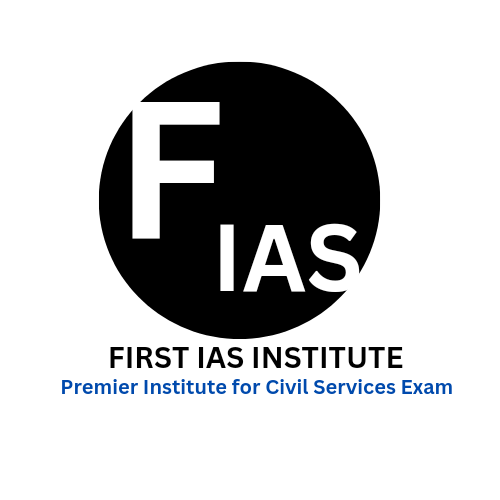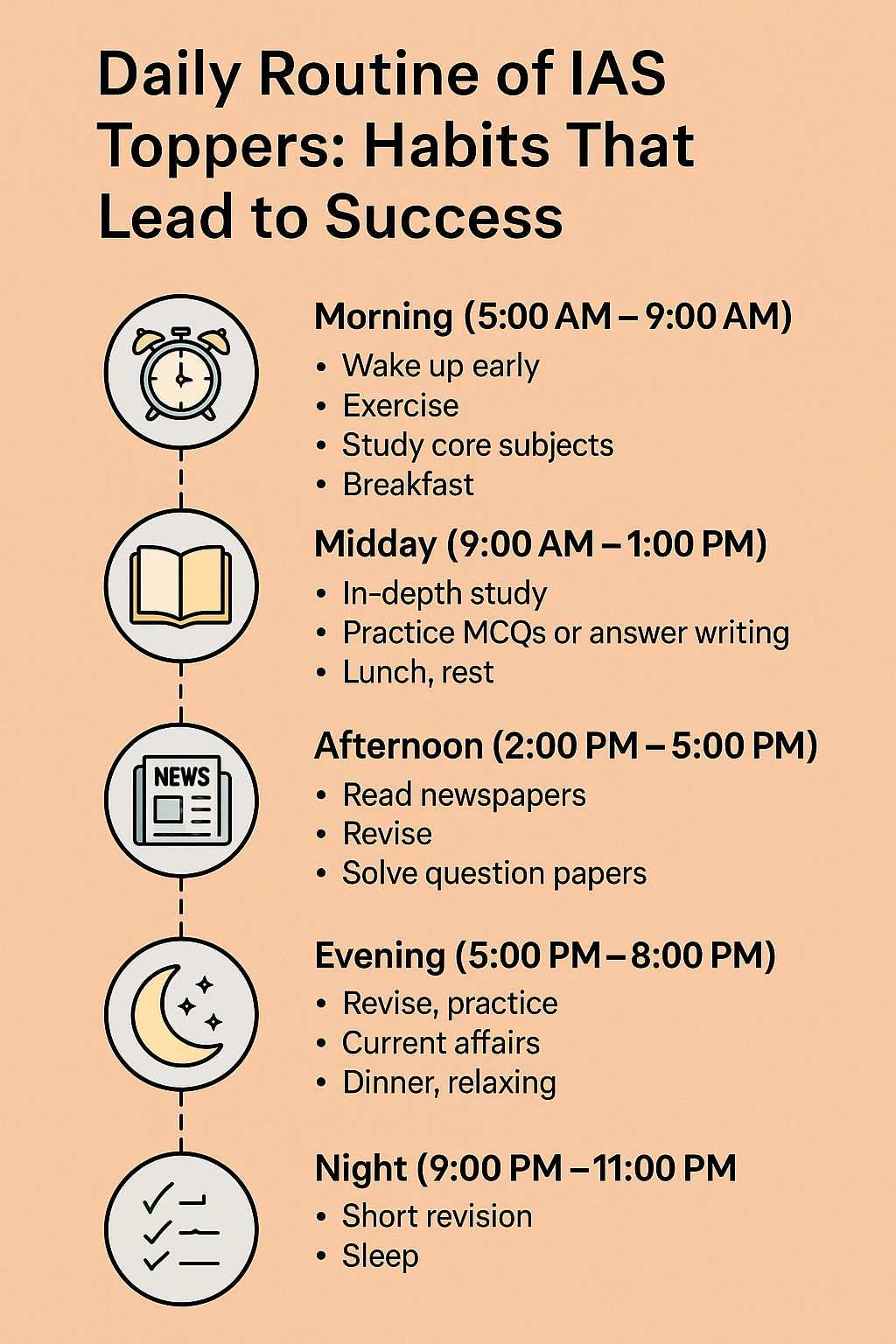Daily Routine of IAS Toppers: Habits That Lead to Success
Cracking the UPSC Civil Services Examination is no easy feat. Every year, lakhs of aspirants compete for a handful of prestigious posts such as IAS, IPS, and IFS. While talent and intelligence play their roles, what truly distinguishes the toppers is their unwavering discipline and a well-crafted daily routine. If you're preparing for the UPSC exam, understanding how toppers structure their day can help you optimize your own schedule and increase your chances of success.
In this blog, we delve into the daily routines and study habits of successful IAS toppers, offering you a blueprint you can adapt to your own lifestyle. These routines aren’t rigid but serve as models to inspire consistency, balance, and productivity.
Join WhatsApp community for Free Notifications, Updates, Study Material, Mock Tests, Internship Updates, and Current Affairs - CLICK HERE TO JOIN
Why a Daily Routine Matters in UPSC Preparation
UPSC preparation is a long-term process, often spanning over a year or more. A consistent routine helps aspirants stay on track, avoid burnout, and ensure comprehensive coverage of the vast syllabus. A proper schedule:
- Ensures disciplined preparation
- Helps avoid procrastination
- Maintains a balance between studies, revision, and answer writing
- Provides time for physical and mental well-being
- Encourages time-bound targets and measurable progress
Many toppers attribute their success not just to studying hard, but to studying smart — and a well-planned routine is at the heart of that strategy.
Sample Daily Routine of IAS Toppers
Let’s explore a sample schedule followed by many successful IAS candidates. Note that this routine is flexible and can be customized to suit individual preferences, strengths, and weaknesses.
Morning (5:00 AM – 9:00 AM)
Most toppers begin their day early. Waking up around 5:00 or 5:30 AM helps to make use of the most peaceful hours of the day when the mind is fresh and distractions are minimal.
After waking up, toppers usually engage in a short physical activity session — this can be a walk, yoga, or light exercise to get the blood flowing and increase focus.
Around 6:00 AM, aspirants dive into their first study session of the day, usually covering subjects that require more focus like Polity, History, or Ethics. This is also a good time to study topics that involve a lot of memorization, such as Geography or Environment.
By 8:00 AM, they break for a light breakfast and refreshment, getting ready to begin the second study session by 8:30 or 9:00 AM.
To Enroll in FIRST IAS INSTITUTE - Click Here
Midday (9:00 AM – 1:00 PM)
This period is often used for concept-building or in-depth study of optional subjects. This is the time when aspirants go through standard books, make notes, and understand the core themes of each subject.
Some candidates also prefer solving MCQs or practicing answer writing during this slot if they are targeting Prelims or Mains respectively.
The focus during these hours is maintaining maximum productivity with minimal breaks. A 5-minute break after every hour or so is often recommended to refresh the mind and avoid fatigue.
Lunch is typically scheduled around 1:00 PM, followed by a short rest period to recharge for the afternoon session.
Afternoon (2:00 PM – 5:00 PM)
The post-lunch session is reserved for lighter tasks such as reading newspapers (The Hindu, Indian Express) or revising already-covered topics. Some toppers dedicate this time to watching video lectures for subjects like Economics or Current Affairs.
The aim during this slot is to reinforce knowledge rather than absorb new information. Revision, mind mapping, and note consolidation are commonly practiced.
Many toppers also solve previous years' question papers or take short mock tests to gauge their preparation.
Evening (5:00 PM – 8:00 PM)
Evenings can be used for self-assessment and targeted practice. Toppers often revise short notes, engage in online quizzes, or practice writing answers to daily questions posted by coaching institutes or found online.
This is also the time to catch up on current affairs, government reports, or Yojana/Kurukshetra summaries.
Around 7:30 or 8:00 PM, aspirants usually take a break for dinner and unwind a bit — perhaps listening to music, talking to family, or doing something to relax.
Night (9:00 PM – 11:00 PM)
Before going to bed, a short revision session is common among toppers. This could include reviewing what was studied during the day, re-reading notes, or planning the schedule for the next day.
A good night’s sleep is considered essential. Most toppers make sure they sleep for at least 6–7 hours, recognizing that mental clarity is critical for long hours of study.
Join WhatsApp community for Free Notifications, Updates, Study Material, Mock Tests, Internship Updates, and Current Affairs - CLICK HERE TO JOIN
Study Habits That Set Toppers Apart
Beyond just daily scheduling, there are some powerful habits that high-ranking IAS candidates consistently follow. Here’s a closer look at those strategies:
1. Consistency Over Intensity
Rather than studying 14–16 hours a day sporadically, toppers emphasize consistent effort. Even a steady 8–10 hours of focused study each day yields better results over time than irregular marathon sessions.
2. Effective Note-Making
Toppers create concise, well-organized notes from standard books and resources. These notes are updated with current affairs and help in quick revision before the exam.
3. Answer Writing Practice
Many IAS toppers stress the importance of answer writing for Mains. They regularly practice writing answers under timed conditions and seek feedback to improve their style, structure, and content delivery.
To Enroll in FIRST IAS INSTITUTE - Click Here
4. Mock Tests
Mock tests are a cornerstone of a topper’s preparation strategy. Whether for Prelims or Mains, regular mock tests help identify weaknesses, improve time management, and build exam temperament.
5. Focused Revision Strategy
The UPSC syllabus is vast, and revision is crucial. Toppers often follow a 3-tier revision strategy — first, shortly after studying a topic; second, after a week or two; and third, during the final days before the exam.
6. Current Affairs Integration
Instead of treating current affairs as a separate subject, toppers integrate them with their static syllabus. For example, linking daily news with related topics in Polity or Economy helps reinforce understanding.
7. Staying Mentally and Physically Healthy
IAS toppers understand the value of mental peace and physical health. Many engage in yoga, meditation, or regular walks. Staying positive and avoiding burnout is essential in a year-long preparation cycle.
Join WhatsApp community for Free Notifications, Updates, Study Material, Mock Tests, Internship Updates, and Current Affairs - CLICK HERE TO JOIN
Real Toppers’ Tips and Routines
Let’s look at what some real-life toppers had to say about their daily schedules:
- Anudeep Durishetty (AIR 1, 2017) mentioned that sticking to a flexible but productive schedule helped him stay focused and cover every aspect of the exam, from GS papers to optional and Ethics.
- Tina Dabi (AIR 1, 2015) followed a routine that emphasized early rising, daily newspaper reading, and answer writing. She also took weekly breaks to relax and rejuvenate.
- Gaurav Agarwal (AIR 1, 2013) credited his success to regular self-assessment, daily target setting, and a simple, distraction-free lifestyle that revolved around consistent learning.
To Enroll in FIRST IAS INSTITUTE - Click Here
Final Thoughts
There is no one-size-fits-all daily routine for UPSC preparation, but what’s common among IAS toppers is their discipline, commitment, and smart study approach. Whether you’re a morning person or a night owl, the key is to create a realistic and sustainable schedule that fits your lifestyle and maximizes your productivity.
Start by identifying your peak productivity hours, choose quality over quantity, and stick to your daily plan with dedication. The IAS dream is achievable — and with the right routine, it’s closer than you think. Stay consistent, stay calm, and believe in your process.


 firstiasofficial@gmail.com
firstiasofficial@gmail.com
Leave a Comment